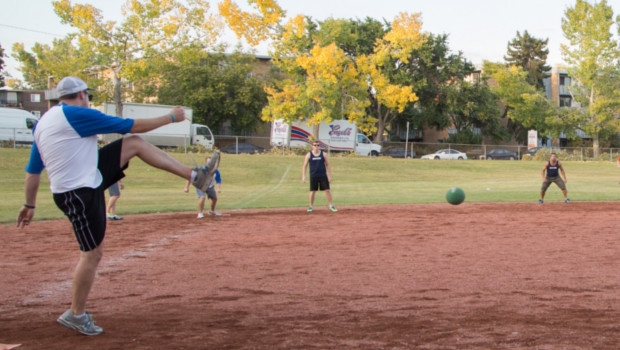
While Kickball is arguably one of the most fun, laid back sports we offer, it is still a sport! With any sport comes strategy and potential to improve. There are ways to strategize both offensively and defensively to maximize your game. Today, we will be laying out some outfield strategies and defensive tips.
- Pay attention and communicate
So many plays are missed because the outfield wasn’t sure where to throw the ball once they tracked it down. Before every new kicker, the outfield should take a look around and look for any players on base. It may be a good idea to designate a player in the field to call out plays before each kicker / play. For example if kicker #3 is coming up to the plate, kicker #1 struck out, and kicker #2 is on first base, the defensive player could call out “1 out, plays to first then second”.
This lets the team know that if they get the ball, they should get it to either first or second base to get the next out based on where the kickers can get to. Letting the team know how many outs the team has also helps to clarify where they are in the inning and keeps everyone on the same page.
- Positioning is key
Another key to mastering the outfield is proper positioning. While the infield is pretty set with 1 player on each base and a short-stop between 2nd and 3rd, the outfield can be a bit more flexible. One thing you want to look for is right vs. left footed kickers. The majority of players will be right footed so you want to have your outfield shifted to the left, some players may use their left foot. In those cases, you may want to shift the outfield to the right as the ball will have more of a tendency to carry that way. If you don’t shift, they could find holes in the outfield.
Another thing to watch for throughout the game is the big kickers or players who tend to kick lower balls. While always keeping the respect line in mind, if a player up to kick tends to keep the ball lower and along the ground, you may want to pinch in a bit to cut it off. Alternatively, if a big-kicker is up to the plate, stay deep as it is much easier to run onto a ball as it is coming in rather than chasing it down if it drops behind you.
- Stop / make a play as quickly as possible
Once the ball is kicked, the play is live until the ball is returned to the pitcher. Once the ball is caught / tracked down, the play should be made as quickly as possible or stopped to prevent extra scoring. One of the biggest mistakes we see is a player in the outfield who picked up the ball and is holding onto it looking for a play. The kicker can continue to run or even score until the ball is to the pitcher. Referring to tip #1 and communicating with your team, help the player with the ball by calling out where they can throw it or providing a cut-off catcher if it is deep in the outfield. If the runner has made it to a base and there is no play to make, be sure to get it in to the pitcher to hold them on base and try your hand at the next one!
Hopefully these tips will help improve your defensive game and hold games within a couple of runs. But as always, be sure to have fun first!




























